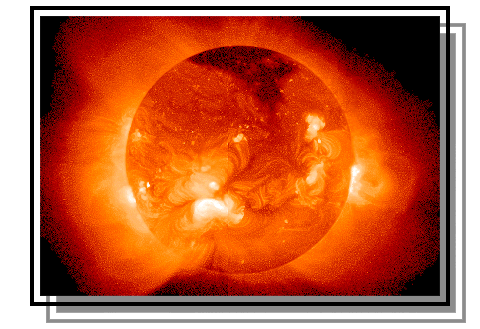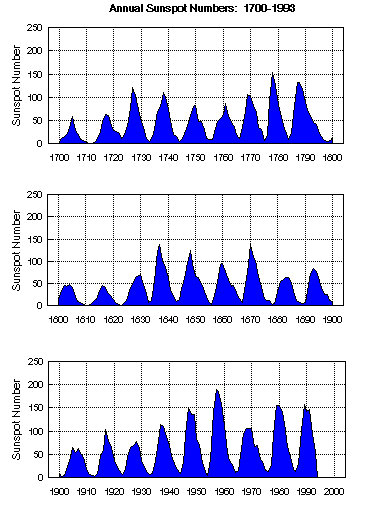

![]()
Part One: General Appearance
Let's begin by looking at an image of today's
Sun from SOHO's EIT telescope, at URL:
Activity: Make a sketch of what you see in this solar image, being sure to include the most notable or interesting features. Invent names for the different types of features.
![]() WARNING: "Naked eye" means just that --
"naked", as in "unprotected and vulnerable". NEVER look straight
at the Sun with your unprotected eyes. You can lose your eyesight, and
YOU WILL NEVER GET IT BACK. There are some safe ways to observe
the Sun -- find out about these safe methods BEFORE you look at the Sun.
WARNING: "Naked eye" means just that --
"naked", as in "unprotected and vulnerable". NEVER look straight
at the Sun with your unprotected eyes. You can lose your eyesight, and
YOU WILL NEVER GET IT BACK. There are some safe ways to observe
the Sun -- find out about these safe methods BEFORE you look at the Sun.
![]()
![]()
Part Two: A Changing Look, or a Constant Face?
Look again at the image of today's Sun.
Do you suppose the Sun always looks like this?
Here are some pictures to show how the Sun appeared on several
other dates. These images were taken in X-rays which are more energetic than today's image in
ultra-violet. However, many of the structures seen in both are similar. Is there any difference in the number and complexity of
the structures you see? Do you suppose
there is any pattern to the Sun's appearance through time? The URL for
these pictures is:
Activity: To look for subtle patterns in data, scientists often plot their data graphically -- pictures show many things that are easily overlooked in tables of numbers. Try making these two graphs to see if any patterns are noticable:
![]()
Part Three: Long-Term Cycles
Compare your plots from Part Two to
these two graphs (see below).
The first shows how the
number of sunspots has changed, day to day, over the last 250 years.
The second shows
the solar latitude of
sunspots during the course of the last 125 years. (There is a
relationship between X-ray active regions and sunspots, so there should be
some relationship between your graphs from Part Two
and these longer-term records.) How
do your graphs
compare to the longer record? Can you predict, even roughly, what the Sun
will look like next year? When you graduate from college? On your
thirtieth birthday?
![]()


![]()
Activity: Download an image taken on June 7, 2000
from URL:
http://solar.physics.montana.edu/YPOP/Classroom/Lessons/Cycles/Images/Xt000607.gif
Compare it to the other images you have. Where in the solar activity
cycle do you think the sun was on that day? Near minimum/maximum activity?
Increasing/Decreasing activity? To help refine your estimate, try
downloading images for two weeks before or after June 7, 2000 -- three or four
pictures should be plenty. You can find lots of recent images in the
First
Light archive at URL:
Test yourself: Here is an
X-ray image. There is no date stamped on the image; it was made sometime
between 1991 and 1995. Try to estimate when
this picture was taken, based on the amount and location of activity.
The URL for this "mystery image" is:
The "Mystery Image" in the above Test Yourself activity is randomly
selected from a set of twelve solar X-ray pictures. Each time you reload
the "Mystery Image" you may get a different picture! A composite
poster of all twelve
images in
the set is viewable here,
and you can
order your own full-size poster at URL:
![]()
Now here is a visible-light
picture of the Sun, and an X-ray picture taken on the same day
(1992Jan23).
Activity: Here are a bunch of
white-light and X-ray
pictures of the Sun. The URL for this puzzle is:
If you could walk outside right now and observe the visible Sun, could you
make predictions about the appearance of today's Sun in invisible
X-rays?
Test yourself: We have provided you with an image of today's Sun made in ultra-violet rays. (See the
above URL.)
Make a guess about what the visible-light Sun looks like today. Make a
sketch of your prediction. Then
download
a white-light picture of today's Sun and compare: how accurate was your
prediction? One site from which you can get a daily (depending on
local weather) solar white-light image is the Big Bear Solar
Observatory in California, at URL:
NOTE: All the X-ray images were taken by the Soft X-ray Telescope (SXT) on the
Yohkoh solar observing satellite. Yohkoh/SXT made more
than two million X-ray pictures of the Sun since its launch in 1991, and
continued making pictures until the satellite was lost in December of 2001.
For most of 1992, SXT also made pictures
in visible light. Towards the end of 1992, however, the harsh radiation
from the Sun began to take its toll on the camera and it is no longer used
for white-light pictures. You can see the effects of the damaging
radiation in some of the 1992 pictures; look for a dark "shadow" near the
right-hand edge of the Sun.
Lesson designed by the YPOP
Team
For questions about this lesson, please contact
David E. McKenziePart Four: Connection to the Visible Sun
Except for today's image, all of the images we have examined so far are all X-ray pictures.
They show the
apperance of the hot outermost layer of the Sun's atmosphere. But since
X-rays are invisible to human eyes, you can't see the coronal structures
simply by walking outside and looking upwards.
The URL for this white/X-ray comparison image is:
Link to an Explanation
![]()
Explanation of the Sunspot-Active Region
Connection
![]()
![]()